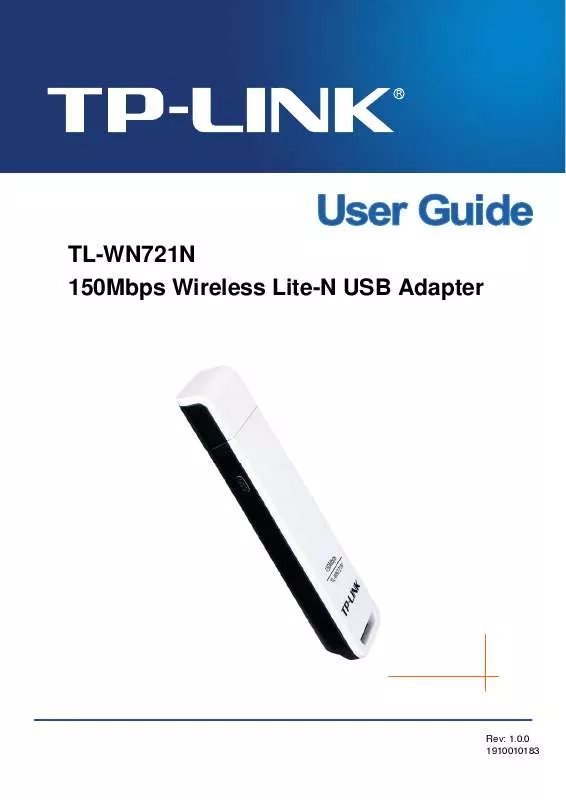User manual TP-LINK TL-WN721N INSTALLATION GUIDE
Lastmanuals offers a socially driven service of sharing, storing and searching manuals related to use of hardware and software : user guide, owner's manual, quick start guide, technical datasheets... DON'T FORGET : ALWAYS READ THE USER GUIDE BEFORE BUYING !!!
If this document matches the user guide, instructions manual or user manual, feature sets, schematics you are looking for, download it now. Lastmanuals provides you a fast and easy access to the user manual TP-LINK TL-WN721N. We hope that this TP-LINK TL-WN721N user guide will be useful to you.
Lastmanuals help download the user guide TP-LINK TL-WN721N.
Manual abstract: user guide TP-LINK TL-WN721NINSTALLATION GUIDE
Detailed instructions for use are in the User's Guide.
[. . . ] TL-WN721N
150Mbps Wireless Lite-N USB Adapter
TL-WN721N 150Mbps Wireless Lite-N USB Adapter
Rev: 1. 0. 0 1910010183
TL-WN721N
150Mbps Wireless Lite-N USB Adapter
COPYRIGHT & TRADEMARKS
Specifications are subject to change without notice. registered trademarks of their respective holders. No part of the specifications may be reproduced in any form or by any means or used to make any derivative such as translation, transformation, or adaptation without permission from TP-LINK TECHNOLOGIES CO. , LTD. Copyright © 2009 TP-LINK TECHNOLOGIES CO. , LTD. [. . . ] · Maximum - Selects maximum mode to let the access point buffer incoming messages for the Adapter. The Adapter will detect the access point if any messages are waiting periodically. Normal - Normal mode uses maximum when retrieving a large number of packets, then switches back to power save mode after retrieving the packets. Off - Turns power saving off, thus powering up the Wireless USB Adapter continuously for a short message response time.
· ·
Network Type: There are basically two modes of networking: · · Infrastructure - All wireless clients will connect to an access point or wireless router. Ad-Hoc - Directly connecting to another computer, for peer-to-peer communication, using wireless network adapters on each computer, such as two or more TL-WN721N wireless adapters.
Note: 1) An Infrastructure network contains an Access Point or wireless router. All the wireless devices or clients will connect to the wireless router or access point. An Ad-Hoc network contains only clients, such as laptops with wireless desktop adapters. All the adapters must be in Ad-Hoc mode to communicate. Wireless Mode: Specifies 2. 4 GHz 150 Mbps, 2. 4 GHz 54 Mbps or 2. 4 GHz 11 Mbps operation in an access point network. The Wireless adapter must match the wireless mode
2)
15
TL-WN721N of the access point with which it associates.
150Mbps Wireless Lite-N USB Adapter
Wireless Mode when Starting an Ad Hoc Network: Specifies 2. 4 GHz 54/11 Mbps to start an Ad Hoc network if no matching network name is found after scanning all available modes. This mode also allows the selection of the channel that the Wireless Adapter uses. The channels available depend on the regulatory domain. If the adapter finds no other ad hoc adapters, the channel that the adapter starts the ad hoc network with will be selected automatically. The Adapter must match the wireless mode and channel of the clients it associates. 802. 11 Authentication Mode: Select which mode the Adapter uses to authenticate to an access point: · · Auto - Automatic causes the adapter to attempt authentication using shared, but switches it to open authentication if shared fails. Open - Open System enables an adapter to attempt authentication regardless of its WEP settings. It will only associate with the access point if the WEP keys on both the adapter and the access point match. Shared - Shared-key only allows the adapter to associate with access points that have the same WEP key.
·
For infrastructure (access point) networks, click Preferred APs. . . to specify four access points at most to the client adapter that attempts to be associated to the access points. The four access points have different priorities; the frontal has the higher priority.
Figure 3-7
3. 2. 2 Remove a profile
1. Go to the Profile Management tab (shown in Figure 3-2). Select the profile name in the Profiles List. [. . . ] A set of two or more BSS in a single network is referred to as an Extended Service Set (ESS). Infrastructure mode is useful at a corporation scale, or when it is necessary to connect the wired and wireless networks. Spread Spectrum - Spread Spectrum technology is a wideband radio frequency technique developed by the military for use in reliable, secure, mission-critical communications systems. It is designed to trade off bandwidth efficiency for reliability, integrity, and security. [. . . ]
DISCLAIMER TO DOWNLOAD THE USER GUIDE TP-LINK TL-WN721N Lastmanuals offers a socially driven service of sharing, storing and searching manuals related to use of hardware and software : user guide, owner's manual, quick start guide, technical datasheets...manual TP-LINK TL-WN721N


